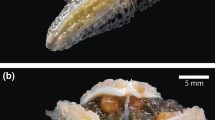Abstract.
Females of Tremoctopus violaceus, Argonauta argo and Ocythoe tuberculata in the Aegean Sea have larger eggs than specimens from the western Mediterranean and open ocean; the most probable reason is a shift in the reproductive strategies of Argonautoidea from the Aegean Sea toward the K-side, because of the high stability of this habitat in contrast to the unstable high seas. Potential fecundity of T. violaceus is 100,000–300,000; batch fecundity is 10,000–30,000, but at the beginning and at the end of spawning the batches are smaller. In A. argo potential fecundity is at least 85,000, with batch fecundity of some 2,000–4,000 eggs. The potential fecundity of small, mature O. tuberculata was 300,000 eggs. T. violaceus is an "intermittent terminal spawner", whereas both A. argo and O. tuberculata are "continuous spawners".
Similar content being viewed by others
Author information
Authors and Affiliations
Additional information
Electronic Publication
Rights and permissions
About this article
Cite this article
Laptikhovsky, .V., Salman, .A. On reproductive strategies of the epipelagic octopods of the superfamily Argonautoidea (Cephalopoda: Octopoda). Marine Biology 142, 321–326 (2003). https://doi.org/10.1007/s00227-002-0959-6
Received:
Accepted:
Issue Date:
DOI: https://doi.org/10.1007/s00227-002-0959-6




